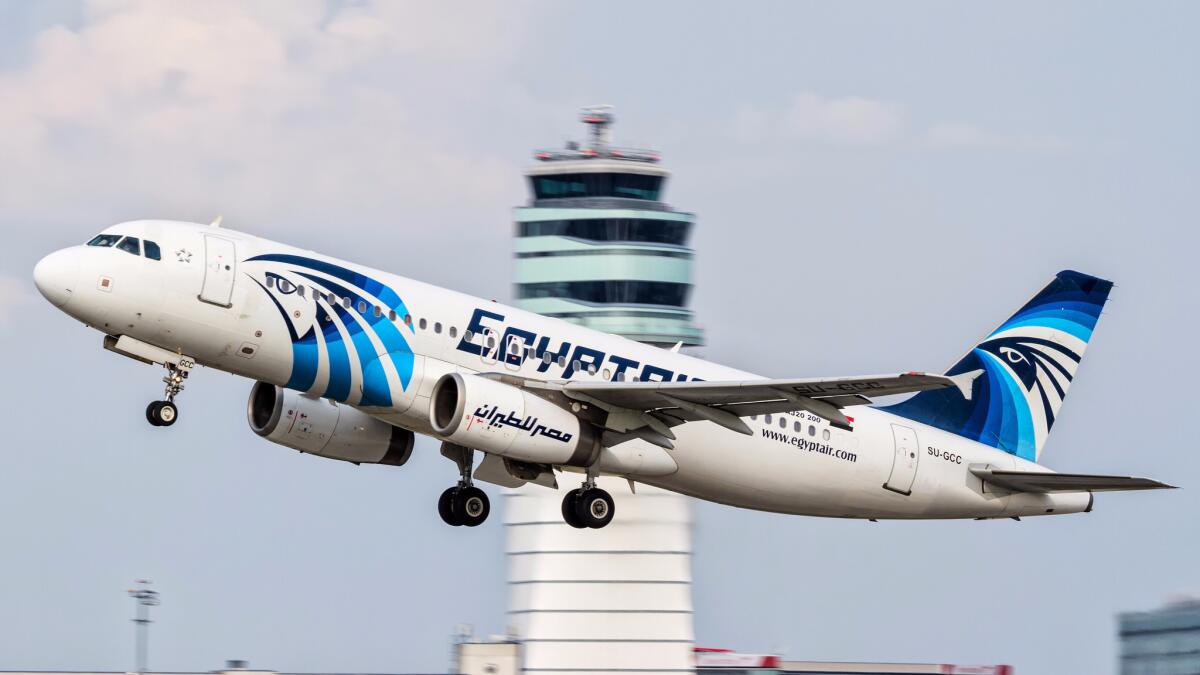Egypt pulls second black box of crashed airliner out of the sea

- Share via
The second black box of the EgyptAir plane that crashed last month killing all 66 people on board was pulled out of the Mediterranean Sea on Friday, a day after Egypt’s investigation committee said the plane’s cockpit voice recorder had been recovered.
The find significantly raises hopes that investigators will finally be able to determine what caused the crash of the EgyptAir Airbus A320. Both France and the United States are sending investigators to Cairo to help with the probe.
The recovery of the black boxes follows a breakthrough earlier in the week, when ships searching part of the Mediterranean north of Egypt spotted the wreckage of the plane and started mapping its debris on the seabed.
It’s still not known what brought the plane down between the Greek island of Crete and the Egyptian coast — or whether the aircraft broke apart in the air, or stayed intact until it struck the water.
No militant group has said it downed the plane, which was flying to Cairo from Paris when it crashed on May 19. The wreckage was believed to be at a depth of about 3,000 meters (9,800 feet). Previously, search crews found only small floating pieces of debris and some human remains.
On Friday, a statement from the Egyptian committee said the vessel John Lethbridge, contracted by the Egyptian government to search for the plane wreckage, pulled the data recorder out of the sea in stages. It added that it managed to “successfully retrieve” the memory unit of the recorder, which is the “most important” component.
While the statement didn’t elaborate on the condition of the recorder, it implied that the memory unit had been safely recovered. The two so-called black boxes were tucked into the plane’s tail.
The committee said that the data will be downloaded and analyzed once it arrives from the port city of Alexandria, where the black boxes will be transferred from the site of the crash.
The committee said that the two recorders will be handed over to investigators after being transferred to the port city of Alexandria. However, earlier in the day, an official in the committee said that the investigators already had started analyzing the cockpit voice recorder after it arrived in Cairo overnight. It was not immediately possible to reconcile the conflicting statements. The official spoke on condition of anonymity because he was not authorized to talk to the media.
France’s Accident Investigating Bureau, or BEA, said Friday it is sending an investigator to Cairo “to lend our technical expertise to the reading of the two recordings.” On Thursday, the U.S. National Transportation Safety Board also said it is sending an investigator and a recorder specialist to Cairo. Honeywell, the U.S. technology company that manufactured the cockpit voice recorder, is providing technical support as well.
A top security official at Cairo International Airport, Brig. Gen. Fahmi Megahed, ordered extra security measures on Friday at the civil aviation ministry headquarters and the investigation team offices, where the recorders will be analyzed. Both are adjacent to the airport.
Flight 804 disappeared from radar about 2:45 a.m. local time, after it had entered Egyptian airspace. Radar data showed the aircraft had been cruising normally in clear skies before it turned 90 degrees left, then a full 360 degrees to the right as it plummeted from 38,000 feet to 15,000 feet. It disappeared from radar when it was at an altitude of about 10,000 feet.
Leaked flight data indicated a sensor had detected smoke in a lavatory and a fault in two of the plane’s cockpit windows in the final moments of the flight.
“The plane clearly suffered an instant severe damage that left it uncontrollable,” said Shaker Kelada, an EgyptAir official who was not involved in the search but has led other crash investigations for the national carrier. He said that finding the black boxes was “a great success” but that “now, time and patience is needed to analyze them.”
Egypt’s civil aviation minister, Sherif Fathi, has said terrorism is a more probable cause than equipment failure or some other catastrophic event.
John Lethbridge, the vessel that found the wreckage, arrived on June 9 at the port of Alexandria, carrying highly specialized equipment of the Deep Ocean Search company. A statement from DOS said the search team eventually narrowed the search to “a depth equal to 10 times the height of London Shard tower” a 95-story skyscraper in London that is nearly 10,000 feet tall. Investigators said earlier that they had narrowed the search area to a three-mile radius of the Mediterranean.
Finding the black boxes was essential and could reveal whether a mechanical fault, a hijacking or a bomb caused the disaster. Investigators also hope the black boxes will offer clues as to why there was no distress call.
There are two on board each plane — a cockpit voice recorder, which should contain a record of the last 30 minutes in the cockpit, and is equipped to detect even loud breathing. The second is the flight data recorder, which would contain technical information on the engines, wings and cabin pressure.
Safety onboard Egyptian aircraft and at the country’s airports have been under close international scrutiny since a Russian airliner crashed in the Sinai Peninsula in October, killing all 224 people on board, shortly after taking off from a Red Sea resort in Egypt.
That crash — claimed by the Islamic State group’s affiliate in the Sinai and blamed by Moscow on an explosive device planted on board the aircraft — decimated Egypt’s tourism industry, which already had been battered by years of turmoil in the country.
More to Read
Sign up for Essential California
The most important California stories and recommendations in your inbox every morning.
You may occasionally receive promotional content from the Los Angeles Times.










